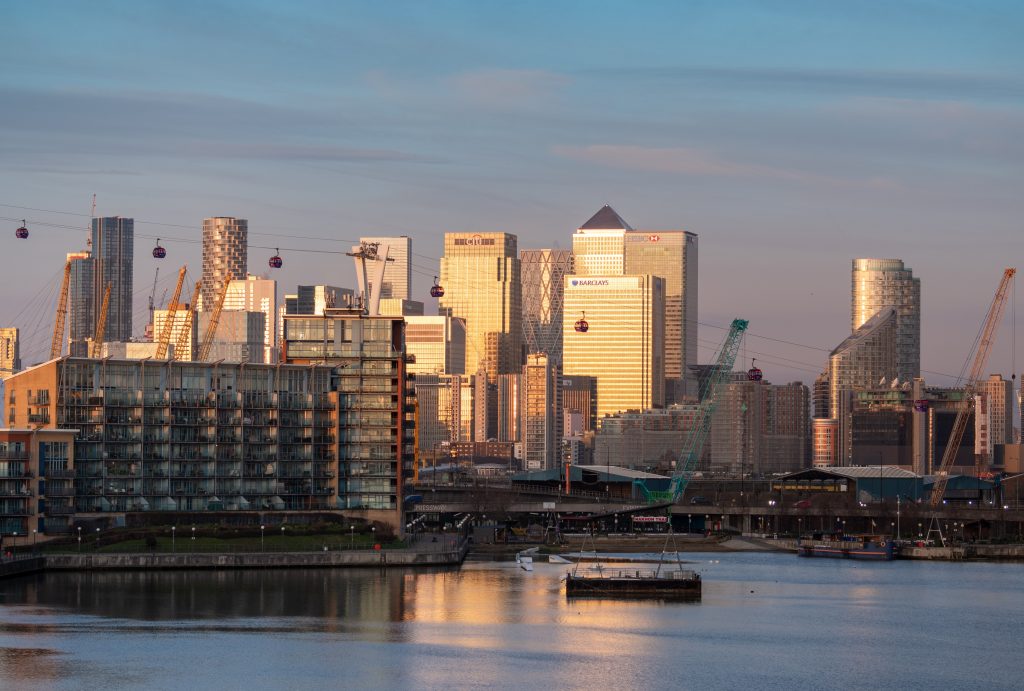A NEW DIRECTION
Office leasing activity across the Docklands has ebbed and flowed since the district’s inception in the 1990s, often in line with the wider economic conditions given the location’s close relationship with the financial sector. Most recently, the greater adoption of hybrid working by traditional in-office industries has led many businesses to review their office needs. This reassessment has created concerns for office dominated areas such as the Docklands, in particular on the Canary Wharf estate. Following the pandemic, we have seen the Canary Wharf Group (CWG) ramping up the other face of the Wharf, developing and promoting amenities, improving tourism as well as expanding the residential footprint to ensure greater diversity and to ensure the district is not left behind.
LONDON’S THIRD FINANCIAL DISTRICT?
Canary Wharf has long been considered the UK’s second financial district after the City. However, financial sector leasing activity in 2022 paints a different picture as we saw West End office take-up overtaking the City, with the Docklands slipping down the rankings to third, accounting for only 11% of total financial sector take-up. That being said, the financial sector remains the dominant occupier in Canary Wharf, with the sector representing 62% of the take-up in this market during 2022. In comparison, the sector’s share in the West End and the City was smaller, at 55% and 13% respectively. This highlights two things to us, financial firms remain drawn to Canary Wharf, but also that there is a smaller range of occupiers than in other office markets around central London.
SECTOR APPEAL NARROWS
Despite the need to attract a more diverse range of occupiers, we have seen the appeal of this market narrow somewhat since the pandemic. Take the Technology sector as an example. Apple leased 66,665 sq ft at 1-5 Bank Street in 2021, expecting similar tech firms to follow suit did not transpire with only 5,814 sq ft having been taken by this sector in 2022.
Similarly, Thomson Reuters decision to remain in the E14 office market with its deal for circa 300,000 sq ft at 5 Canada Square in 2016 did not stimulate wider media sector leasing. Our research shows that no media firm has leased space in this market since 2019, with it being the case that in Q1 2023 office leasing across this market was limited to just three sectors, the Financial (25%), Corporate (24%) and Education (52%) sectors.
NEW DEVELOPMENTS TO FUEL DEMAND
New developments across central London are increasingly attracting businesses who are looking to secure efficient, sustainable, and innovative offices, not discounting new and refurbished spaces across the E14 postcode.
With its focus to drive greater sector diversity CWG has joined forces with Kadans, a life science building developer, to create a new 750,000 sq ft life-science focused wet lab, the first part of a wider health and life sciences driven development of the North Quay site, next to the Elizabeth Line station.
Developing new stock is all well and good, but the market remains awash with vacant space (3.6 m sq ft) with availability across the market 89% higher than at the start of the pandemic (Q1 2020). Secondhand space accounts for a significant proportion of available stock, and therefore those more discerning occupiers may find that the higher-quality options available in Docklands are not as plentiful as expected. That being said, we are starting to see a wave of refurbishments of original developments, including the new YY building at 30 South Colonnade and 25 Canada Square.

OFFERING FLEX SOLUTIONS IN THE WHARF
In 2019, flexible office providers leased 30% of the space let in the Docklands. This has proved to be a high point with no providers committing to new space since, which is symptomatic of both the level of saturation of the flexible office market in Canary Wharf and lower levels of business demand.
A number of major providers such as WeWork already have a strong foothold within the market. Even landlord CWG offer a flexible product with MadeFor, launched in 2022. Capitalising on its significant space holding, CWG’s managed office provision offers spaces in several desirable buildings including the iconic One Canada Square and new development 20 Water Street. Considering this step into the flex world and CWG’s suggestion that around a fifth of its office portfolio will be flex space, other providers seem to have been discouraged from launching in the Wharf.
A TALE OF TWO GRADES
Prime Grade A rents have seen little movement in the Docklands since the onset of the pandemic, remaining at £52.50 per sq ft until Q4 2022 when they edged up marginally by 5% to £55.00 per sq ft, the result of heightened demand for the best-in-class spaces (at the upper tower levels). However, unlike other office markets where the onset of the pandemic led to downward revisions in headline rents, the Docklands held onto its top level, giving way on more generous rent-frees instead. In fact, given the recent rise, Grade A rents are now 22% higher than those recorded in 2018. On the other hand, reduced demand for Grade B spaces across Central London coupled with the plethora of available secondhand spaces in Canary Wharf, has meant that Prime Grade B rents are now 13% below the level recorded at the start of the pandemic, currently at £32.50 per sq ft. This represents an opportunity for occupiers to pick up spaces of a decent quality at a reasonable rent.
OUTLOOK
When planning for the redevelopment of the East End docks commenced in the 1980s/90s, the focus was very much upon creating a hub for large financial firms. Three decades on and the business landscape has changed, with occupiers taking a different approach to their space use and size requirements. Landlords can no longer rely on a single business taking the whole of a tower building. Spaces, both new and existing, need to be more flexible with the ability to split and multi-let the larger floors. This would ensure that the buildings remain suitable (size-wise) to the modern occupier, who is heavily influenced by hybrid working practices.
In addition, we are likely to see the proportion of Grade A available space increase, as buildings are refurbished to meet environmental and sustainable targets, as well as fulfil tenant expectations. Furthermore, the greater accessibility of the Wharf with the arrival of the Elizabeth Line should encourage more occupiers to take office space, as well as increase footfall. Combined with the fact that rents in this market remain below the average for Central London, this will ensure that Canary Wharf remains attractive for occupiers going forward. Specifically, further attempts to broaden the appeal of the district to other sectors, including encouraging ecosystems to flourish by doubling down on the provision of specialised office spaces, could initiate a renaissance of the Docklands office market.
By Mark James, Junior Research Analyst



